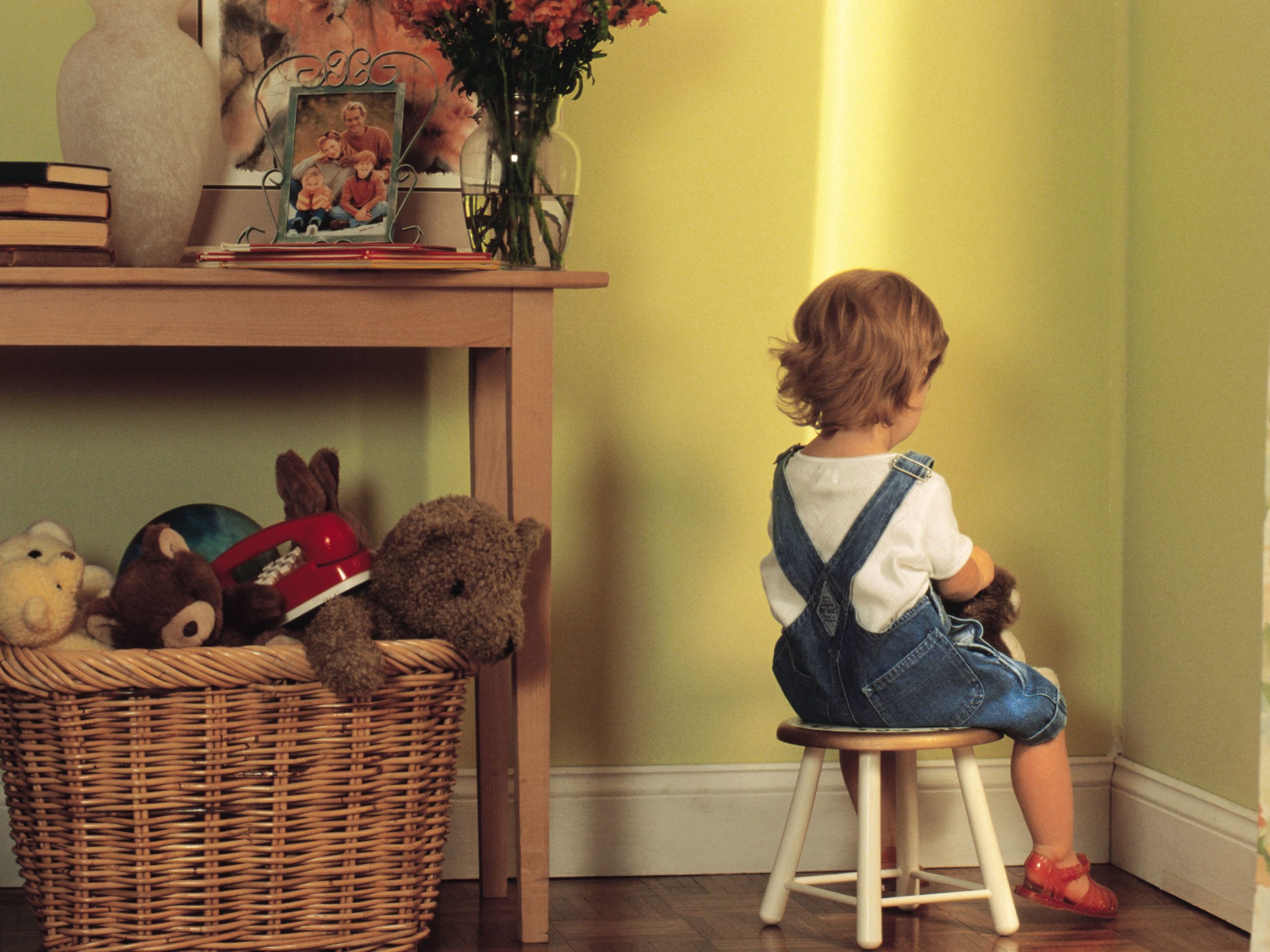
Time-out is a very popular method for disciplining children. It has both advocates for and against it and this article will explore the possibility that both of them are right. It will define time-out, explain how it should be used according to research and lastly, how the lack of research stirs debates about it.
Time-out is a very popular method for disciplining children. It has both advocates for and against it and this article will explore the possibility that both of them are right. It will define time-out, explain how it should be used according to research and lastly, how the lack of research stirs debates about it.

Photo from Comstock / Getty Images
Time-out (TO) is a discipline practice in which a child is taken away from positive reinforcement (an environment that is rewarding) for a brief period of time, with the intention to stop an unwanted behavior (American Psychological Association, n.d.). It is a form of punishment because it changes behavior by doing something unpleasant to the child – removing positive reinforcement. TO is generally meant for children between the ages of 2 and 8 years old, and should last up to 5 minutes for pre-schoolers (Jones & Downing, 1991, cited in Morawska et al., 2010). TO is used often by parents (Ryan et al., 2016), although a recent study found a decline in its use due to concerns about potential negative effects (Canning et al., 2021). Research until now has shown TO to be effective in changing behavior, in reducing physical violence against children, and studies failed to find aversive effects for children in the long run (Quetsch et al., 2015, cited in Tully and Dadds, 2019). Despite this, TO has received a great deal of criticism.
Morawska et al. (2010) and Tully and Dadds (2019) identified some of the concerns that TO critics have:
- It leads the child to focus on misbehavior instead of good behavior
- It labels children as naughty
- It is inefficient
- It makes the child feel abandoned and isolated
- It does not teach the child what desirable behavior he should show instead
- It harms the relationship with parents
- It does not address underlying causes of inappropriate behavior
Among researchers, proponents of TO argue that the points of critique are not warranted if parents apply TO correctly, as a part of what they call a positive parenting strategy. A positive parenting strategy assumes that children are generally well-intended/good, but can misbehave. They need to be respected and discipline should guide them to learn good behaviors. Thus, the proponents advocate for a TO in which parents remain calm, do not threaten or humiliate the child, are able to monitor the child from a distance, stop TO when children are calm and show signs that they will behave appropriately. Most importantly, they maintain that TO is not to be used in situations when the child is stressed, frightened or has had an accident (Morawska et al., 2010). TO should be limited to: physical aggression, disruption of property, inappropriate sexual behavior, and non-compliance and oppositionality of children (Drayton et al., 2014). Moreover, for TO be effective, outside of TO the child should be part of a positive, loving environment where instructions about good behaviors are given explicitly and the consequence of inappropriate behavior (i.e., TO) is predictable and understood by the child (Morawska et al., 2010).
“There is an ideal form of TO, which is when parents apply it correctly from beginning to end.”
Tully and Dadds (2019) further argue that the criticism could be applied to any discipline strategy that is incorrectly used, suggesting that not TO itself is flawed, but the way in which some parents might implement it. Using insights from social learning theory, attachment theory, emotion regulation theory as well as the ecological or family systems theory, they formulate the following guidelines for disciplining strategies, including TO, that support children’s mental health and development:
- Parents should make sure the child is able to change and control the behavior he or she is supposed to either suppress or initiate. Children should not be disciplined for their inability, fear, mistakes/accidents or overwhelming emotions. In such cases, parents should offer supportive teaching responses, not discipline.
- In time, the efficacy of a disciplining strategy should be seen in the decreased need to use them. TO should become unnecessary.
- Parents should keep calm and signal that the relationship between them and the child is not affected. The child should be reassured that he or she will not be abandoned. Their parent’s love and care will not be withdrawn.
- TO should be stopped when the child shows regulation of behavior, not after an arbitrary amount of time decided by the parent. It should also be applied fairly (for example, to all children in the household if they behave inappropriately).
- Before any conflict arises, children should be told that TO will be enforced if they behave inappropriately and that it is supposed to help them regulate their behaviors or calm down. Parents should teach children how to regulate emotions and behavior through their own example or through explicit instruction, before the need to discipline.
- TO should be used for prespecified behaviors and children should understand why these behaviors are not adequate. In addition, the type of behaviors that will be met with a TO should match what is right and wrong in the society, so the parents should be able to give cultural, moral and pragmatic reasons against the behaviors.
Having seen what TO is and how it should be applied, one starts to realize that there is an ideal form of TO, which is when parents apply it correctly from beginning to end. However, critics still seem to warn against what could happen in practice. Should we take this criticism seriously? Definitely. Most instances of child abuse happen in discipline contexts (Strauss, 2000, cited in Tully and Dadds, 2019). The vast majority of studies that support TO come from intervention programs where parents were instructed about TO and therefore they implement it correctly (for a review, see Everett et al., 2010). There are not as many survey studies asking parents how they actually apply TO, but in one such study Riley et al. (2017) found considerable errors in its implementation, with as much as 85% of parents using TO in a way that is contradictory to guidelines from empirical research. Furthermore, an analysis of parenting websites has shown that information about TO is incomplete, inaccurate and inconsistent (Drayton et al., 2014), both in terms of how it should be applied and in terms of how effective it is.
“All the details of the good TO procedure show how easy it is to get it wrong.”
The debate about TO seems to be maintained by a difference between theory and practice. Thus, it is not entirely correct to dismiss the concerns of critics by saying that research counteracts them because research focuses on the effects of the best version of TO possible. It is very difficult to study the actual implementation of TO inside families because few people would admit that their version of TO is “I get very angry and I shout: I had enough of you, go to your room until I say so”. Furthermore, research on the situations in which parents use TO seems to be lacking. The same for research into what “removing the positive reinforcer” looks like in practice. In other words, what exactly is the child not allowed to do during TO? TO could be effective even if it is not implemented correctly, but it could still be inappropriate or harm children – something that both the proponents and the critics seem to realize. All the details of the good TO procedure show how easy it is to get it wrong. Critics of TO worry about problems that could arise if this happens. More research about the implementation of TO by untrained parents is needed to see if this is the case. Until then, the bottom line is that there are few reasons to believe that a well-applied TO is ineffective or harmful to children, but the criticism does raise important questions about how it might be implemented in reality. <<
References
–American Psychological Association. (n.d.). Time out. In APA dictionary of psychology.
-Canning, M. G., Jugovac, S., & Pasalich, D. S. (2021). An Updated Account on Parents’ Use of and Attitudes Towards Time-Out. Child Psychiatry & Human Development, 1-14.
-Dadds, M. R., & Tully, L. A. (2019). What is it to discipline a child: What should it be? A reanalysis of time-out from the perspective of child mental health, attachment, and trauma. American Psychologist, 74(7), 794.
-Drayton, A. K., Andersen, M. N., Knight, R. M., Felt, B. T., Fredericks, E. M., & Dore-Stites, D. J. (2014). Internet guidance on time out: Inaccuracies, omissions, and what to tell parents instead. Journal of developmental and behavioral pediatrics: JDBP, 35(4), 239.
-Everett, G. E., Hupp, S. D., & Olmi, D. J. (2010). Time-out with parents: A descriptive analysis of 30 years of research. Education and Treatment of Children, 33(2), 235-259.
-Morawska, A., & Sanders, M. (2011). Parental use of time out revisited: A useful or harmful parenting strategy?. Journal of Child and Family Studies, 20(1), 1-8.
-Riley, A. R., Wagner, D. V., Tudor, M. E., Zuckerman, K. E., & Freeman, K. A. (2017). A survey of parents’ perceptions and use of time-out compared to empirical evidence. Academic pediatrics, 17(2), 168-175.
-Ryan, R. M., Kalil, A., Ziol-Guest, K. M., & Padilla, C. (2016). Socioeconomic gaps in parents’ discipline strategies from 1988 to 2011. Pediatrics, 138(6).
Time-out (TO) is a discipline practice in which a child is taken away from positive reinforcement (an environment that is rewarding) for a brief period of time, with the intention to stop an unwanted behavior (American Psychological Association, n.d.). It is a form of punishment because it changes behavior by doing something unpleasant to the child – removing positive reinforcement. TO is generally meant for children between the ages of 2 and 8 years old, and should last up to 5 minutes for pre-schoolers (Jones & Downing, 1991, cited in Morawska et al., 2010). TO is used often by parents (Ryan et al., 2016), although a recent study found a decline in its use due to concerns about potential negative effects (Canning et al., 2021). Research until now has shown TO to be effective in changing behavior, in reducing physical violence against children, and studies failed to find aversive effects for children in the long run (Quetsch et al., 2015, cited in Tully and Dadds, 2019). Despite this, TO has received a great deal of criticism.
Morawska et al. (2010) and Tully and Dadds (2019) identified some of the concerns that TO critics have:
- It leads the child to focus on misbehavior instead of good behavior
- It labels children as naughty
- It is inefficient
- It makes the child feel abandoned and isolated
- It does not teach the child what desirable behavior he should show instead
- It harms the relationship with parents
- It does not address underlying causes of inappropriate behavior
Among researchers, proponents of TO argue that the points of critique are not warranted if parents apply TO correctly, as a part of what they call a positive parenting strategy. A positive parenting strategy assumes that children are generally well-intended/good, but can misbehave. They need to be respected and discipline should guide them to learn good behaviors. Thus, the proponents advocate for a TO in which parents remain calm, do not threaten or humiliate the child, are able to monitor the child from a distance, stop TO when children are calm and show signs that they will behave appropriately. Most importantly, they maintain that TO is not to be used in situations when the child is stressed, frightened or has had an accident (Morawska et al., 2010). TO should be limited to: physical aggression, disruption of property, inappropriate sexual behavior, and non-compliance and oppositionality of children (Drayton et al., 2014). Moreover, for TO be effective, outside of TO the child should be part of a positive, loving environment where instructions about good behaviors are given explicitly and the consequence of inappropriate behavior (i.e., TO) is predictable and understood by the child (Morawska et al., 2010).
“There is an ideal form of TO, which is when parents apply it correctly from beginning to end.”
Tully and Dadds (2019) further argue that the criticism could be applied to any discipline strategy that is incorrectly used, suggesting that not TO itself is flawed, but the way in which some parents might implement it. Using insights from social learning theory, attachment theory, emotion regulation theory as well as the ecological or family systems theory, they formulate the following guidelines for disciplining strategies, including TO, that support children’s mental health and development:
- Parents should make sure the child is able to change and control the behavior he or she is supposed to either suppress or initiate. Children should not be disciplined for their inability, fear, mistakes/accidents or overwhelming emotions. In such cases, parents should offer supportive teaching responses, not discipline.
- In time, the efficacy of a disciplining strategy should be seen in the decreased need to use them. TO should become unnecessary.
- Parents should keep calm and signal that the relationship between them and the child is not affected. The child should be reassured that he or she will not be abandoned. Their parent’s love and care will not be withdrawn.
- TO should be stopped when the child shows regulation of behavior, not after an arbitrary amount of time decided by the parent. It should also be applied fairly (for example, to all children in the household if they behave inappropriately).
- Before any conflict arises, children should be told that TO will be enforced if they behave inappropriately and that it is supposed to help them regulate their behaviors or calm down. Parents should teach children how to regulate emotions and behavior through their own example or through explicit instruction, before the need to discipline.
- TO should be used for prespecified behaviors and children should understand why these behaviors are not adequate. In addition, the type of behaviors that will be met with a TO should match what is right and wrong in the society, so the parents should be able to give cultural, moral and pragmatic reasons against the behaviors.
Having seen what TO is and how it should be applied, one starts to realize that there is an ideal form of TO, which is when parents apply it correctly from beginning to end. However, critics still seem to warn against what could happen in practice. Should we take this criticism seriously? Definitely. Most instances of child abuse happen in discipline contexts (Strauss, 2000, cited in Tully and Dadds, 2019). The vast majority of studies that support TO come from intervention programs where parents were instructed about TO and therefore they implement it correctly (for a review, see Everett et al., 2010). There are not as many survey studies asking parents how they actually apply TO, but in one such study Riley et al. (2017) found considerable errors in its implementation, with as much as 85% of parents using TO in a way that is contradictory to guidelines from empirical research. Furthermore, an analysis of parenting websites has shown that information about TO is incomplete, inaccurate and inconsistent (Drayton et al., 2014), both in terms of how it should be applied and in terms of how effective it is.
“All the details of the good TO procedure show how easy it is to get it wrong.”
The debate about TO seems to be maintained by a difference between theory and practice. Thus, it is not entirely correct to dismiss the concerns of critics by saying that research counteracts them because research focuses on the effects of the best version of TO possible. It is very difficult to study the actual implementation of TO inside families because few people would admit that their version of TO is “I get very angry and I shout: I had enough of you, go to your room until I say so”. Furthermore, research on the situations in which parents use TO seems to be lacking. The same for research into what “removing the positive reinforcer” looks like in practice. In other words, what exactly is the child not allowed to do during TO? TO could be effective even if it is not implemented correctly, but it could still be inappropriate or harm children – something that both the proponents and the critics seem to realize. All the details of the good TO procedure show how easy it is to get it wrong. Critics of TO worry about problems that could arise if this happens. More research about the implementation of TO by untrained parents is needed to see if this is the case. Until then, the bottom line is that there are few reasons to believe that a well-applied TO is ineffective or harmful to children, but the criticism does raise important questions about how it might be implemented in reality. <<



